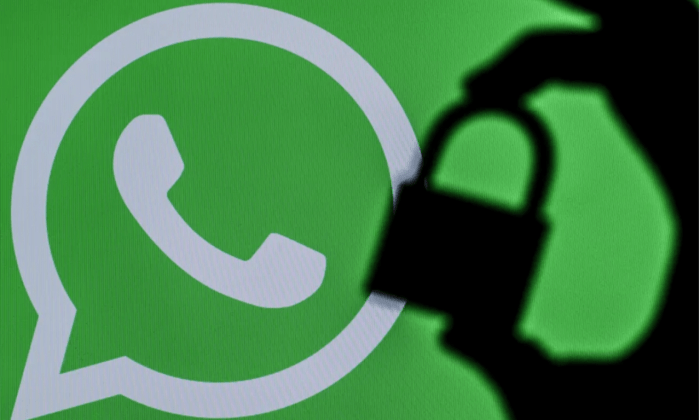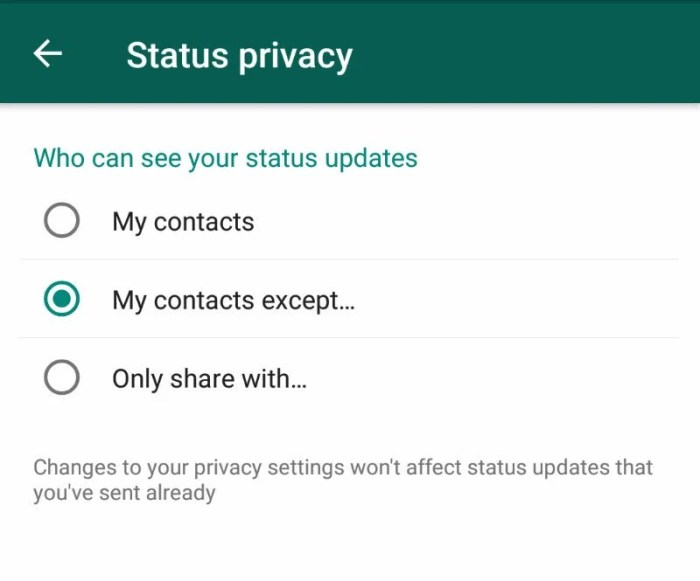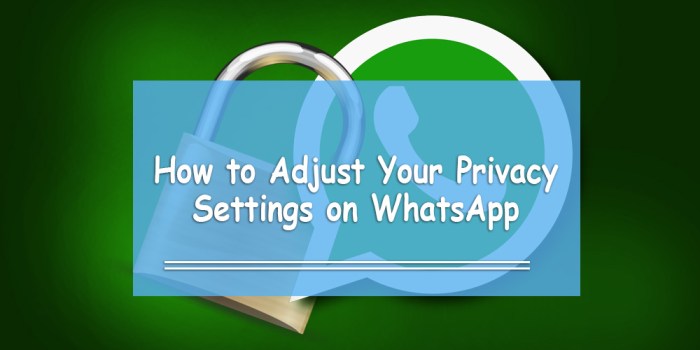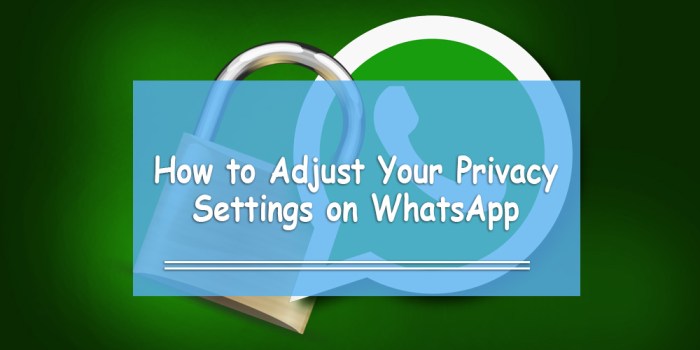WhatsApp Privacy Settings You Need to Know Today – WhatsApp Privacy Settings: A Comprehensive Guide to Protect Your Data. In the digital age, privacy has become paramount, and understanding the intricacies of WhatsApp’s privacy settings is essential. This guide delves into the various privacy options available, empowering you to control your online presence and safeguard your personal information.
WhatsApp has emerged as a ubiquitous messaging platform, connecting billions worldwide. However, with its popularity comes concerns about data privacy. This guide provides a comprehensive overview of WhatsApp’s privacy settings, enabling you to make informed decisions about your online interactions and protect your sensitive information.
Understanding WhatsApp Privacy Settings

WhatsApp’s privacy settings are crucial for controlling who can see your personal information and how your data is used. Understanding these settings is essential for maintaining your privacy and security while using the app.
Privacy Options in WhatsApp
WhatsApp offers a range of privacy options, including:
- Last Seen:Controls who can see the time of your last WhatsApp activity.
- Profile Picture:Determines who can view your profile picture.
- About:Allows you to set a brief description that can be seen by others.
- Status:Lets you post temporary updates that are visible to your contacts.
- Read Receipts:Enables you to see when your messages have been read.
- Group Settings:Allows you to control who can add you to groups and who can see your group activity.
- Location Sharing:Gives you the option to share your real-time location with others.
- End-to-End Encryption:Ensures that messages and calls are encrypted between devices, providing a high level of privacy.
Controlling Profile Visibility
Managing your profile visibility is crucial for maintaining privacy on WhatsApp. Here’s a breakdown of the settings you can adjust:
Profile Picture Visibility
- Go to Settings> Account> Privacy> Profile Picture.
- Choose from three options: Everyone, My Contacts, or Nobody.
- Selecting My Contactsallows only people in your address book to see your profile picture.
About Section Visibility
- Navigate to Settings> Account> Privacy> About.
- Select from the same options as for Profile Picture: Everyone, My Contacts, or Nobody.
- Choosing Nobodyhides your About section from everyone, including your contacts.
Last Seen Status, WhatsApp Privacy Settings You Need to Know Today
- Access Settings> Account> Privacy> Last Seen.
- Options include Everyone, My Contacts, My Contacts Except…, or Nobody.
- Selecting My Contacts Except…allows you to hide your Last Seen status from specific contacts.
Managing Group Privacy
WhatsApp groups are a great way to stay connected with friends and family, but it’s important to manage your privacy settings to ensure that you’re comfortable with who can add you to groups and how your information is shared.
Here are some tips for managing group privacy on WhatsApp:
Who Can Add You to Groups
- Go to WhatsApp Settings.
- Tap Account > Privacy.
- Under “Groups,” select one of the following options:
- Everyone: Anyone can add you to groups.
- My Contacts: Only people in your contacts list can add you to groups.
- Nobody: No one can add you to groups.
Leaving or Muting Groups
- Open the group chat.
- Tap the group name at the top of the screen.
- Tap “Exit Group” or “Mute Notifications.”
Managing Group Notifications
- Open the group chat.
- Tap the group name at the top of the screen.
- Tap “Notifications.”
- Select one of the following options:
- Default: You will receive notifications for all messages.
- Custom: You can choose to receive notifications for only certain types of messages, such as @mentions or direct messages.
- Mute: You will not receive any notifications for messages in this group.
End-to-End Encryption

End-to-end encryption is a security measure that ensures that only the sender and recipient of a message can read it. This is in contrast to traditional encryption methods, which encrypt messages in a way that allows third parties, such as the service provider, to access them.End-to-end
encryption is important for privacy because it prevents third parties from intercepting and reading messages. This is especially important for sensitive messages, such as those containing personal information or financial data.WhatsApp uses end-to-end encryption for all messages, calls, and video calls.
This means that your messages are encrypted on your device and decrypted on the recipient’s device. WhatsApp does not have access to the encryption keys, so it cannot read your messages.
Examples of End-to-End Encryption
* When you send a message to someone on WhatsApp, the message is encrypted on your phone using a unique key.
- The encrypted message is then sent to the recipient’s phone.
- The recipient’s phone uses the same key to decrypt the message.
- Only the sender and recipient have access to the key, so only they can read the message.
End-to-end encryption is an important security measure that helps to protect your privacy. By using WhatsApp, you can be sure that your messages are safe from prying eyes.
Sharing Sensitive Information: WhatsApp Privacy Settings You Need To Know Today
WhatsApp is a popular messaging app that allows users to share text, photos, videos, and other files. While WhatsApp offers end-to-end encryption for all messages, it’s important to be aware of the risks of sharing sensitive information on the platform.
One of the biggest risks is that your messages could be intercepted by a third party, such as a hacker or government agency. This could happen if your phone is hacked, or if the WhatsApp servers are compromised. Another risk is that your messages could be stored on WhatsApp’s servers indefinitely, even if you delete them from your phone.
Tips for Protecting Sensitive Information
- Avoid sharing sensitive information on WhatsApp, such as your Social Security number, credit card number, or bank account information.
- If you must share sensitive information, use WhatsApp’s disappearing messages feature. This feature allows you to set a timer for your messages, after which they will be automatically deleted from both your and the recipient’s phones.
- Be aware of the privacy settings on WhatsApp and make sure they are set to your liking.
- Only share sensitive information with people you trust.
Privacy Concerns and Data Collection
WhatsApp collects various types of data, including user information, device information, usage data, and location data. This data collection is essential for the operation of the app, such as enabling messaging, maintaining user accounts, and improving the overall user experience.
Data Collection Practices
WhatsApp collects the following types of data:
- User information:This includes the user’s phone number, name, profile picture, and status message.
- Device information:This includes the device model, operating system, and IP address.
- Usage data:This includes information about the user’s usage patterns, such as the frequency of messages sent and received, and the duration of calls.
- Location data:This includes the user’s current location, which can be used for features such as location sharing and nearby friends.
Privacy Concerns
The collection of this data raises several privacy concerns, including:
- Data sharing with third parties:WhatsApp shares some of the data it collects with third parties, such as Facebook, for advertising and marketing purposes.
- Government access to data:Governments can request access to WhatsApp user data for law enforcement purposes.
- Data breaches:WhatsApp has experienced data breaches in the past, which have resulted in the exposure of user data.
Recommendations for Mitigating Privacy Risks
Users can take several steps to mitigate the privacy risks associated with WhatsApp’s data collection practices:
- Review privacy settings:Regularly review and adjust WhatsApp’s privacy settings to control the amount of data collected.
- Limit data sharing:Disable features that share data with third parties, such as location sharing and nearby friends.
- Use a VPN:Using a virtual private network (VPN) can help protect user data from being intercepted by third parties.
- Consider alternative messaging apps:There are other messaging apps available that offer more privacy-friendly features than WhatsApp.
Conclusion

In conclusion, WhatsApp’s privacy settings offer a robust framework for managing your online presence and protecting your personal data. By understanding and utilizing these settings effectively, you can safeguard your privacy, control your visibility, and minimize potential risks. Remember, privacy is not just a right but a responsibility, and it starts with taking ownership of your online interactions.
Embrace the power of WhatsApp’s privacy settings and navigate the digital world with confidence.
FAQ Corner
What is end-to-end encryption, and why is it important?
End-to-end encryption ensures that messages are encrypted from the sender’s device to the recipient’s device, making them inaccessible to third parties, including WhatsApp itself. It is crucial for maintaining privacy and protecting sensitive communications.
How can I control who can add me to groups?
You can manage who can add you to groups by adjusting your group privacy settings. You can choose to allow only contacts to add you, or you can restrict it to specific contacts or no one at all.
What are the risks of sharing sensitive information on WhatsApp?
Sharing sensitive information, such as financial data or personal documents, on WhatsApp can pose risks if your account is compromised or your messages are intercepted. It is advisable to exercise caution and avoid sharing highly sensitive information on messaging platforms.

